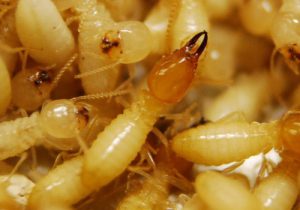DAVIE, Fla. – When species exhibit unexpected mating behaviors, it begs the critical question as to why.
A study published back in 2015 by UF/IFAS researchers reported unusual mating behaviors between two invasive termite species in Florida known as the Asian subterranean termite and the Formosan subterranean termite. This newly observed mating behavior left scientists wondering about the possible impacts and outcomes of such behavior, as it could potentially result in the establishment of hybrid termites.
Now, this abnormal mating behavior has an explanation according to a new study released this month in the Journal of Chemical Ecology by Thomas Chouvenc, an assistant professor at UF/IFAS, Fort Lauderdale Research and Education Center, and his international colleagues.

“We now understand the reason for this behavior: the mating confusion between the two species is all about sex pheromones,” said Chouvenc, whose original study reported the unusual mating behavior in 2015.
Typically, animals rely on signals from potential mates to engage in sexual activity and reproduce. In birds and mammals, many of these signals are often visual or acoustic. In insects, chemical communication is primarily used, explains Chouvenc. Sex pheromones are usually produced by females to attract a male and engage in mating activity.
Chouvenc, along with two international colleagues, were able to confirm that the sex pheromone produced by females of both termite species is identical, and males, therefore, rely on the same chemical cue to find females. However, Formosan subterranean termite females produce ten times the amount of sex pheromones compared to Asian subterranean termite females.

“Essentially, males of both species are trying to detect the same perfume to find a female, but because Formosan subterranean termite females produce much more pheromone, it appears to be much more appealing than termite females of their own species,” said Chouvenc. “This ultimately results in mating confusion, as males of both species preferentially engage in mating behavior with Formosan subterranean termite females.”
A previous study in 2015 from Chouvenc’s lab showed that such mating confusion can result in the hybridization between the two invasive termite species, raising concerns on unforeseen and long-term consequences of biological invasions.
The Asian subterranean termite and the Formosan subterranean termite are among the two most destructive termite species in the world and both are invasive in Florida. They impact structures and urban tree canopies and have historically swarmed at different times. However, since the 2010s, their geographic distribution and their mating seasons have been reported as overlapping in southeast Florida, adds Chouvenc. This overlapping observation has been a concern of scientists as to whether it could result in a hybrid termite between two destructive species.
During termite mating season, winged termites fly out of their colony to disperse, find a mate, and create new colonies as kings and queens. Because the two invasive termite species are now swarming at the same place and the same time, they now have the opportunity to interact and mate.
Usually, sex among different animal species is not possible because of the existence of mating barriers that evolved over millions of years of evolution, describes Chouvenc. Such barriers can be as simple as a difference in timing for breeding season, or behavioral differences that emerged during speciation, reinforcing species isolation over evolutionary times.
In the case of the Asian and the Formosan subterranean termites, they have evolved separately in Southeast Asia and in China, respectively, for an estimated 18 million years, according to Chouvenc.
“It is possible that during all this time, the mating cues were conserved and no mating barriers were pressured to evolve to maintain species boundaries,” said Chouvenc. “However, because of global human activity, the two species have been moved around and are now interacting in their invasive range, in ways we did not expect, here in South Florida.”
Chouvenc’s research team now focuses on studying the biology of hybrid termites to determine if they could establish, survive, and spread in Florida and beyond in a foreseeable future.
-30-
By: Lourdes Rodriguez, 954-577-6363 office, 954-242-8439 mobile, rodriguezl@ufl.edu
The mission of the University of Florida Institute of Food and Agricultural Sciences (UF/IFAS) is to develop knowledge relevant to agricultural, human, and natural resources and to make that knowledge available to sustain and enhance the quality of human life. With more than a dozen research facilities, 67 county Extension offices, and award-winning students and faculty in the UF College of Agricultural and Life Sciences, UF/IFAS brings science-based solutions to the state’s agricultural and natural resources industries and all Florida residents.
 0
0
